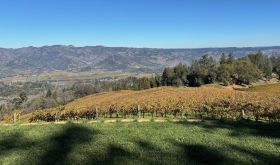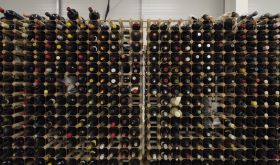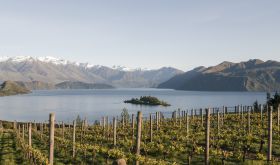Wine styles have evolved enormously this century, from concentrated and beefy to fresher and lighter. But no varietal wine has changed as much as Chardonnay. The Chardonnay that featured so frequently in Bridget Jones’s Diary was big, bold and comforting. It wouldn’t be now.
White burgundy is the classic (and most expensive) example of Chardonnay, even though it rarely says Chardonnay on the label, and Meursault is one of white burgundy’s most famous names. The stereotypical Meursault of the 1990s was described as ‘buttery’. Today I defy any taster to find butteriness in any of the Meursaults made by the village’s most admired exponents, the likes of Coche-Dury, Roulot and Arnaud Ente. Kitchen descriptors of contemporary Meursaults would be more likely to include lemon juice, salt, even the steeliness of a knife blade. These wines are taut and tense with marked acidity.
The same evolution is evident in just about all Chardonnays. Overt oakiness, so fashionable towards the end of the last century, is way out of fashion. The adjectives Chardonnay producers now like to use about their wines are ‘mineral’, ‘steely’, ‘crisp’, ‘ethereal’, ‘fine-boned’ and so on.
As tastes have changed, and summers are warming up in traditional wine regions, all over the world new, cooler regions have been developed to provide grapes for this new, slimline style.
Even California, whose Chardonnays for so long tasted sweet and oaky with more than a hint of popcorn, has seen a step change in the style of Chardonnays made by all but the most commercial producers. Today’s California hotspots for sought-after Chardonnays are Sta Rita Hills in Santa Barbara County and Sonoma’s chilly coast (not necessarily all of the Sonoma Coast appellation, which is far too extensive and includes some relatively warm inland areas). Almost on the Pacific coast there are vineyards – many of them only relatively recently planted – that are regularly shrouded in fog and pummelled by wind. Grapes can struggle to ripen here.
The Sta Rita Hills wine region, a six-hour drive south, is not quite as close to the ocean but is wide open to icy Pacific influence because of a gap in the coastal range. Cold winds in the afternoon and nocturnal fogs make this one of California’s coolest districts. The result in both cases is the sort of high-acid Chardonnays currently in vogue.
Oregon to the immediate north of California is in the process of discovering its aptitude for the Chardonnay grape, having concentrated almost exclusively on Pinot Noir reds for years. The climate in Oregon wine country is, or at least has been, generally much cooler than in California so the state naturally produces Chardonnays with freshness as well as fruit.
For those of us in the UK, the textbook Chardonnay of the late twentieth century was Australian – surely Bridget Jones’s favourite. It was instantly recognisable. The gold had a distinctly greenish tinge, the result of a national obsession then current in protecting Australian grape juice and wine from oxygen. But once fermentation was over, Chardonnays were exposed liberally to oak, so a typical Australian Chardonnay then was greenish, rich and oaky.
Fast forward a decade or two and Australian Chardonnay was transformed into a wine so tart and lean that some became positively austere. The best Australian Chardonnays made today retain the zest but have discernible fruit, too. New regions, earlier picking (by hand rather than machine), ambient yeasts, much less protective winemaking, larger or older barrels with less obvious oak flavour have all played a part.
New Zealand is an obvious place to look for wines with zest. Average temperatures are considerably lower than those of any Australian wine region other than Tasmania (whose Chardonnays can be exemplary). This means that brisk acidity is a leitmotif of NZ wines, as is evident in the oceans of Sauvignon Blanc produced. But I have long argued that New Zealand Chardonnay is a much more interesting wine than most Sauvignon Blancs.
The dramatic weight-loss phenomenon so evident across the Tasman doesn’t seem to have affected NZ Chardonnays, which have always had an agreeable balance between ripe fruit and refreshing acidity. Kumeu River, a family winery in the Auckland suburbs, has long been hailed as a valid challenger to white burgundy, sharing a US importer with Domaine de le Romanée-Conti, no less.
Like New Zealand, South Africa is well able to produce the sort of refreshing Chardonnays that are fashionable today, thanks to cooling ocean currents, and in some cases to usefully high vineyards where nights are cool. South African wines also have the great advantage, for consumers rather than producers, of relatively keen prices.
The Chardonnay Association of South Africa recently organised a blind tasting in their most important export market, the UK, of 34 Chardonnays, including 12 from outside South Africa: five white burgundies; an unexpectedly high number, three, made from English grapes; and two each from cooler parts of California and Australia.
After the wines were identified, we were supplied with the lowest online price for each of them. The average price given for the South African Chardonnays was about £36, an average dragged up by the £65 asked for one of the best wines shown, from wine producer Creation, Glenn’s Chardonnay 2023, but three wines were under £20. The average price of the English wines was £39, the two Australian wines were £28 and £44 respectively, each of the two California wines was £50, and the average price of the five burgundies was £79.
Most of the South African Chardonnays were notably good value, none more so than the Graham Beck sparkling Blanc de Blancs. Chardonnay is not just the world’s most-planted white wine grape, it’s also the most versatile, making wines still, sparkling and even occasionally sweet. Virtually all champagnes, except those labelled Blanc de Noirs, contain Chardonnay and those labelled Blanc de Blancs are almost invariably 100% Chardonnay.
Almost all of the world’s wine regions produce some Chardonnay and many of them, including Ontario and both the Yarra Valley and the Adelaide Hills in Australia, see it as a speciality of theirs. Argentina, of course, specialises in Malbec but I’ve long been impressed by some Argentine Chardonnays.
There is no shortage of fine Chardonnay in the world, but it’s a particularly homogeneous category, not least because they all tend to be made the same way (see below). Probably the most difficult question in last week’s Master of Wine tasting exams would have been: ‘These three wines are all Chardonnays. Where does each come from?’
Worthwhile Chardonnays
Haute Cabrière, Réserve Chardonnay 2023 Franschhoek 12.5%
The 2022 is £16.99 Hard to Find Wines
Cavalli Chardonnay 2023 Stellenbosch 13.1%
£18.95 Mumbles Fine Wines
Graham Beck, Blanc de Blancs Méthode Cap Classique 2019 Robertson 12.4%
£19 Majestic but vintage may be 2018 or 2019
Domaine Jean Vaudoisey Chardonnay 2022 Bourgogne 12.5%
£22.96 Private Cellar
Dog Point Chardonnay 2022 Marlborough 13%
£25 The Wine Society
Restless River, Vineyard Selection Chardonnay 2023 Upper Hemel-en-Aarde Valley 13.3%
£27.50 VINVM, £28.95 AG Wines and others
Murdoch Hill Chardonnay 2021 Adelaide Hills 13%
£27.99 Adnams
Neudorf, Rosie’s Block Amphora Chardonnay 2023 Nelson 13.5%
£30.99 All About Wine, £35 Hic!
Jean-Paul and Benoît Droin 2022 Chablis 12.5%
£33 Four Walls Wine Company
Whalehaven, Reserve Series Seascape Chardonnay 2024 Upper Hemel-en-Aarde Valley 12%
The 2023 (the first vintage made by Richard Kershaw MW) is £35 Amathus
Kumeu River, Hunting Hill Chardonnay 2022 Kumeu 13.5%
£38 R&B Wines and others
Bilancia, Kaikora Vineyard Chardonnay 2022 Hawke’s Bay 13%
The 2021 is £42 The Wine Treasury
Giant Steps, Sexton Vineyard Chardonnay 2023 Yarra Valley 13.5%
£44 London End Wines
Tasting notes, scores and suggested drinking dates of the vintages listed, sometimes a little younger than those currently in commercial circulation, are in our tasting notes database. For international stockists, see Wine-Searcher.com.
Back to basics
| How is Chardonnay made? |
|
Although overt oakiness is out of fashion, Chardonnay has a particular affinity for oak. The classic white-burgundy recipe is to sort the just-picked grapes before putting whole bunches in a press that squeezes out the juice. At one time this was done so as to protect the grapes and juice from oxygen (as the Australians once did obsessively) but today some oxidation at this stage is encouraged as it results in more complex flavours and makes the final wine more stable.
This sweet juice, some of which may be described as free-run, ie run out of the press because of the weight of the grapes, without pressure being applied, is then transferred to barrels. There it ferments into a dry, alcoholic liquid under the action of yeast, which converts the grape sugar into alcohol. The winemaker decides whether to add a specially cultured yeast or, slightly riskier, to let the yeast naturally present in the winery and on the grapes do the job.
Yeast reacts favourably with oak, which nowadays is chosen not to impart oak flavour but because over time it exposes the wine to tiny, beneficial amounts of oxygen, and wine in barrels is clarified and stabilised naturally. The lees of the fermentation naturally fall to the bottom of the barrel and winemakers who want as much useful contact between the lees and the wine may regularly stir the barrels for added texture. A modern alternative is a concrete egg, in which the shape is thought to keep the lees in constant suspension.
After a few months in barrel, during which the various compounds in the young wine combine to form more complex ones, the young wine is typically transferred to a tank for the blend from individual barrels and casks to knit together before bottling.
But some producers, either for reasons of cost or stylistic preference, make their Chardonnay entirely in temperature-controlled stainless-steel tanks or, increasingly and more expensively, in vessels made of concrete, clay or terracotta. |













